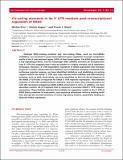Cis-acting elements in its 3′ UTR mediate post-transcriptional regulation of KRAS
Author(s)
Kim, Minlee; Kogan, Nicole E.; Slack, Frank J.
DownloadKim-2016-Cis-acting elements.pdf (3.350Mb)
OPEN_ACCESS_POLICY
Open Access Policy
Creative Commons Attribution-Noncommercial-Share Alike
Terms of use
Metadata
Show full item recordAbstract
Multiple RNA-binding proteins and non-coding RNAs, such as microRNAs (miRNAs), are involved in post-transcriptional gene regulation through recognition motifs in the 3′ untranslated region (UTR) of their target genes. The KRAS gene encodes a key signaling protein, and its messenger RNA (mRNA) contains an exceptionally long 3′ UTR; this suggests that it may be subject to a highly complex set of regulatory processes. However, 3′ UTR-dependent regulation of KRAS expression has not been explored in detail. Using extensive deletion and mutational analyses combined with luciferase reporter assays, we have identified inhibitory and stabilizing cis-acting regions within the KRAS 3′ UTR that may interact with miRNAs and RNA-binding proteins, such as HuR. Particularly, we have identified an AU-rich 49-nt fragment in the KRAS 3′ UTR that is required for KRAS 3′ UTR reporter repression. This element contains a miR-185 complementary element, and we show that overexpression of miR-185 represses endogenous KRAS mRNA and protein in vitro. In addition, we have identified another 49-nt fragment that is required to promote KRAS 3′ UTR reporter expression. These findings indicate that multiple cis-regulatory motifs in the 3′ UTR of KRAS finely modulate its expression, and sequence alterations within a binding motif may disrupt the precise functions of trans-regulatory factors, potentially leading to aberrant KRAS expression.
Date issued
2016-02Department
Massachusetts Institute of Technology. Department of Biological EngineeringJournal
Oncotarget
Publisher
Impact Journals/National Center for Biotechnology Information (U.S.)
Citation
Kim, Minlee, Nicole Kogan, and Frank J. Slack. “Cis-Acting Elements in Its 3′ UTR Mediate Post-Transcriptional Regulation of KRAS.” Oncotarget (March 14, 2016). © 2016 Impact Journals, LLC
Version: Final published version
ISSN
1949-2553